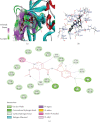High-Throughput Docking and Molecular Dynamics Simulations towards the Identification of Potential Inhibitors against Human Coagulation Factor XIIa
- PMID: 32549905
- PMCID: PMC7261338
- DOI: 10.1155/2020/2852051
High-Throughput Docking and Molecular Dynamics Simulations towards the Identification of Potential Inhibitors against Human Coagulation Factor XIIa
Abstract
Human coagulation factor XIIa (FXIIa) is a trypsin-like serine protease that is involved in pathologic thrombosis. As a potential target for designing safe anticoagulants, FXIIa has received a great deal of interest in recent years. In the present study, we employed virtual high-throughput screening of 500,064 compounds within Enamine database to acquire the most potential inhibitors of FXIIa. Subsequently, 18 compounds with significant binding energy (from -65.195 to -15.726 kcal/mol) were selected, and their ADMET properties were predicted to select representative inhibitors. Three compounds (Z1225120358, Z432246974, and Z146790068) exhibited excellent binding affinity and druggability. MD simulation for FXIIa-ligand complexes was carried out to reveal the stability and inhibition mechanism of these three compounds. Through the inhibition of activated factor XIIa assay, we tested the activity of five compounds Z1225120358, Z432246974, Z45287215, Z30974175, and Z146790068, with pIC50 values of 9.3∗10-7, 3.0∗10-5, 7.8∗10-7, 8.7∗10-7, and 1.3∗10-6 M, respectively; the AMDET properties of Z45287215 and Z30974175 show not well but have better inhibition activity. We also found that compounds Z1225120358, Z45287215, Z30974175, and Z146790068 could be more inhibition of FXIIa than Z432246974. Collectively, compounds Z1225120358, Z45287215, Z30974175, and Z146790068 were anticipated to be promising drug candidates for inhibition of FXIIa.
Copyright © 2020 Dongfang Xu et al.
Conflict of interest statement
The authors declare that they have no conflicts of interest.
Figures






Similar articles
-
An anticoagulant peptide from Porphyra yezoensis inhibits the activity of factor XIIa: In vitro and in silico analysis.J Mol Graph Model. 2019 Jun;89:225-233. doi: 10.1016/j.jmgm.2019.03.019. Epub 2019 Mar 21. J Mol Graph Model. 2019. PMID: 30921556
-
Microscale Parallel Synthesis of Acylated Aminotriazoles Enabling the Development of Factor XIIa and Thrombin Inhibitors.ChemMedChem. 2021 Dec 14;16(24):3672-3690. doi: 10.1002/cmdc.202100431. Epub 2021 Aug 4. ChemMedChem. 2021. PMID: 34278727 Free PMC article.
-
New Infestin-4 Mutants with Increased Selectivity against Factor XIIa.PLoS One. 2015 Dec 15;10(12):e0144940. doi: 10.1371/journal.pone.0144940. eCollection 2015. PLoS One. 2015. PMID: 26670620 Free PMC article.
-
Factor XII/XIIa inhibitors: Their discovery, development, and potential indications.Eur J Med Chem. 2020 Dec 15;208:112753. doi: 10.1016/j.ejmech.2020.112753. Epub 2020 Aug 20. Eur J Med Chem. 2020. PMID: 32883641 Review.
-
Factor XII: a novel target for safe prevention of thrombosis and inflammation.J Intern Med. 2015 Dec;278(6):571-85. doi: 10.1111/joim.12430. Epub 2015 Sep 16. J Intern Med. 2015. PMID: 26373901 Review.
Cited by
-
New Blood Coagulation Factor XIIa Inhibitors: Molecular Modeling, Synthesis, and Experimental Confirmation.Molecules. 2022 Feb 12;27(4):1234. doi: 10.3390/molecules27041234. Molecules. 2022. PMID: 35209023 Free PMC article.
References
-
- Koenig J. M., Chahine A., Ratnoff O. D. Inhibition of the activation of Hageman factor (factor XII) by soluble human placental collagens types III, IV, and V. Journal of Laboratory and Clinical Medicine. 1991;117(6):523–527. - PubMed
-
- Samuel M., Pixley R. A., Villanueva M. A., Colman R. W., Villanueva G. B. Human factor-xii (Hageman-factor) autoactivation by dextran sulfate - circular-dichroism, fluorescence, and ultraviolet difference spectroscopic studies. Journal of Biological Chemistry. 1992;267(27):19691–19697. - PubMed
MeSH terms
Substances
LinkOut - more resources
Full Text Sources
Medical
Research Materials

